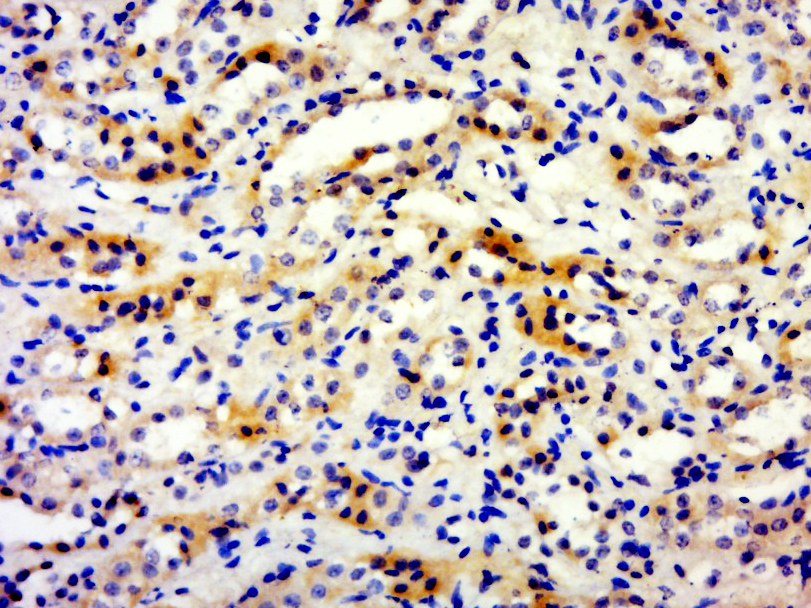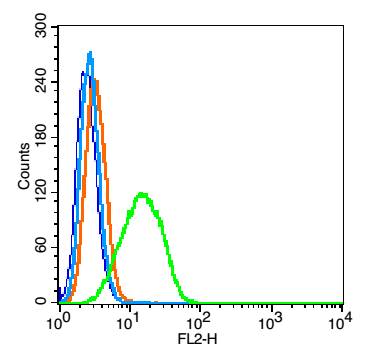
Rabbit Anti-Biliverdin Reductase antibody
Biliverdin Reductase; Biliverdin IX alpha reductase; Biliverdin reductase A; BLVR A; BLVR; BLVRA; BVR A; BVR; BVRA; zinc-metalloprotein; BIEA_HUMAN.
View History [Clear]
Details
Product Name Biliverdin Reductase Chinese Name 胆绿素还原酶抗体 Alias Biliverdin Reductase; Biliverdin IX alpha reductase; Biliverdin reductase A; BLVR A; BLVR; BLVRA; BVR A; BVR; BVRA; zinc-metalloprotein; BIEA_HUMAN. Research Area Cell biology immunology Signal transduction Kinases and Phosphatases The new supersedes the old Immunogen Species Rabbit Clonality Polyclonal React Species Human, Rat, (predicted: Mouse, Pig, ) Applications ELISA=1:5000-10000 IHC-P=1:100-500 IHC-F=1:100-500 Flow-Cyt=1μg/Test ICC=1:100-500 IF=1:100-500 (Paraffin sections need antigen repair)
not yet tested in other applications.
optimal dilutions/concentrations should be determined by the end user.Theoretical molecular weight 33kDa Cellular localization cytoplasmic Form Liquid Concentration 1mg/ml immunogen KLH conjugated synthetic peptide derived from human BLVRA/Biliverdin Reductase: 161-260/296 Lsotype IgG Purification affinity purified by Protein A Buffer Solution 0.01M TBS(pH7.4) with 1% BSA, 0.03% Proclin300 and 50% Glycerol. Storage Shipped at 4℃. Store at -20 °C for one year. Avoid repeated freeze/thaw cycles. Attention This product as supplied is intended for research use only, not for use in human, therapeutic or diagnostic applications. PubMed PubMed Product Detail In human liver cytosolic fractions, four forms of biliverdin reductase have been identified, including two biliverdin-IX Beta reductases and two biliverdin-IX Alpha reductases, designated isozymes I and II and isozymes III and IV, respectively. Biliverdin reductase A (BLVRA), also designated biliverdin-IX Alpha-reductase, belongs to the GFO/iIDH/MocA family and the biliverdin reductase subfamily. The gene that encodes this cytoplasmic protein maps to chromosome 7p14-cen. BLVRA reduces biliverdin IX ?(the ?methene bridge of the open tetrapyrrole) to bilirubin with the concomitant oxidation of an NADH or NADPH cofactor (bilirubin + NADP+ = biliverdin + NADPH). BLVRA is expressed primarily in liver.
Function:
Biliverdin Reductase (BVR) catalyzes the final step in the heme metabolic pathway, the reduction of biliverdin IX{alpha} to bilirubin, with the concomitant oxidation of a NADH or NADPH cofactor. The enzyme remains unique among all biological catalysts described to date in having a dual pH/cofactor-dependent activity profile. Human biliverdin reductase (hBVR) has been recently shown to be a Ser/Thr/Tyr kinase in the MAPK insulin/insulin-like growth factor 1 (IGF1)-signaling cascade. BVR together with its substrate, biliverdin, and product, bilirubin, have recently been revealed to be important players in cellular signal transduction pathways, gene expression and oxidative response. These features make BVR unusually interesting and unique among all enzymes characterized to date.
Subunit:
Monomer.
Subcellular Location:
Cytoplasmic
Tissue Specificity:
Liver.
DISEASE:
Defects in BLVRA are the cause of hyperbiliverdinemia(HBLVD) [MIM:614156]. HBLVD is a condition characterized by a greendiscoloration of the skin, urine, serum, and other bodily fluids.It is due to increased biliverdin resulting from inefficientconversion to bilirubin. Affected individuals appear to havesymptoms only in the context of obstructive cholestasis and/orliver failure. In some cases, green jaundice can resolve afterresolution of obstructive cholestasis.
Similarity:
Belongs to the Gfo/Idh/MocA family. Biliverdinreductase subfamily.
SWISS:
P53004
Gene ID:
644
Database links:Entrez Gene: 644 Human
Entrez Gene: 109778 Mouse
Omim: 109750 Human
SwissProt: P53004 Human
SwissProt: Q9CY64 Mouse
Unigene: 488143 Human
Product Picture
Primary Antibody:Rabbit Anti- Biliverdin Reductase antibody(SL12868R), Dilution: 1μg in 100 μL 1X PBS containing 0.5% BSA;
Isotype Control Antibody: Rabbit IgG(orange) ,used under the same conditions );
Secondary Antibody: Goat anti-rabbit IgG-PE(white blue), Dilution: 1:200 in 1 X PBS containing 0.5% BSA.
Bought notes(bought amounts latest0)
No one bought this product
User Comment(Total0User Comment Num)
- No comment





 +86 571 56623320
+86 571 56623320
 +86 18668110335
+86 18668110335

